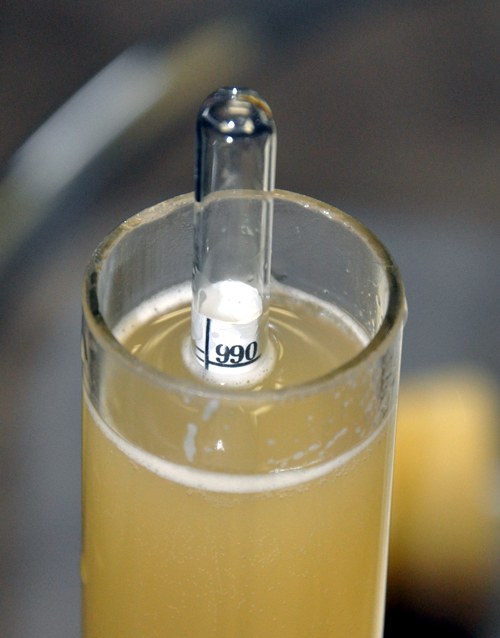
It certainly sounds like you are getting into the dryness zone. Specific gravity is the ratio of the density of a liquid in relation to the density of water, calibrated at a specific temperature (usually 60 or 68 °F/16 or 20 °C). Depending on which source you check (various winemaking books, websites, etc.) folks seem to agree that “dry” table wine usually clocks in around 0.990–0.996 specific gravity.
Why the range? Every wine is different and as such, every wine does actually contain a small amount of non-fermentable sugars and it’s unusual for a wine to go so low as to achieve “no sugar” 0.00 g/L glucose + fructose. “Dry” is philosophically defined (in my opinion) as not enough sugar left to taste or that any yeast cell will ferment as well as the place where the fermentation naturally stops and the yeast just can’t ferment anymore. Most professional winemakers I know chemically define this point as 2 g/L residual sugar (RS) or less (<0.2%) though I have seen wines naturally settle at around 3 g/L RS or 0.3%.
Also don’t forget that specific gravity (SG) is a measure of density. There are a lot of things other than water and sugar that can affect the density of a wine so be sure you’re accounting for as many of those as you can. What is your wine sample’s temperature? As stated earlier, SG is usually calibrated against water at 60 or 68 °F (16 or 20 °C) measuring a specific gravity of 1.000 (check yours to make sure this is correct). If your wine is warm, it’ll be artificially less dense, and your reading will be off. Similarly, if your wine is colder than 60 °F (< 16 °C) it’ll be artificially dense and the hydrometer will float higher than it should. For this reason it’s important to check a hydrometer temperature correction chart to get an accurate reading. Carbon dioxide bubbles can also attach to the hydrometer, floating it artificially high, so do be sure to give it a spin in your measuring cylinder to dislodge them. Also make sure you’re reading the hydrometer line at eye level. If you look down on your hydrometer from above it can give a slightly skewed reading as a result.
If you’re following all of these good hydrometer-use tips and are seeing the same measure day over day, it’s likely your fermentation is finished. Have you ever heard of the Clinitest (sometimes called “the sugar pill”) method for testing for residual/fermentable sugar? You can buy little tablets that diabetics use to check their urine for sugar. By dropping a Clinitest tablet into a measured sample of your wine, and comparing the resulting color to a calibrated chart, you can see if there are any residual reducing sugars in your wine. This is a great (and quick, cheap, and easy) way to see if you’re dry or not once you start getting below 0.990 on the good ol’ hydrometer. Do be aware, however, that the tablets (copper sulfate is part of what makes them react) will also react with many of the pigments and phenolics in red wines, so red wine results tend to skew a little higher than white wines. You can help work around this by diluting a sample of red wine and multiplying the result accordingly. Please do realize that Clinitest tablets are not meant for internal consumption; they are poisonous so do not drink the test sample and be sure to keep away from pets and curious kids. Even if you’re still seeing bubbles on the top of your fermenter, it could just be carbon dioxide gas that’s escaping naturally or it could also mean you have a simultaneous malolactic fermentation going on, so gas bubbles are not always the best indicator at this stage.
Every wine is different and as such, every wine does actually contain a small amount of non-fermentable sugars and it’s unusual for a wine to go so low as to achieve ‘no sugar’ 0.00 g/L glucose + fructose.
Assuming your wine is dry, what’s the best protocol for the next step? You don’t mention what kind of wine you’re making in your question, but I’ll assume just for fun it’s a dry red table wine that you’d like to go through malolactic fermentation (MLF) and which you’re planning on storing in carboys with oak beans (or chips or sticks) for aging. Chilling the wine down is fine and will help settling, but if you do want it to go through the MLF that’s not a step that I recommend. Malolactic (ML) bacteria are inhibited by cold temperatures below 65 °F (18 °C). If you’re pretty sure the wine is dry, then let it sit for a few days to let the lees settle and rack off the heaviest lees into another clean, gassed container. I often use the phrase, “If it flows, it goes” to describe this phase — taking the light and medium lees (discard the heavy, sticky lees) is good for wine because they will break down later in the wine, helping to create a fuller, rounder mouthfeel. At this stage, in the carboy it’ll be sitting in for a while, I recommend adding about 55 grams of oak chips or beans per 5 gallons (19 L) of wine, which is about 3 g/L. Let the wine sit on the oak for two to three months, then taste it again and see if you’d like to add more. Be sure to keep your containers topped up — a topped wine is a happy wine!




